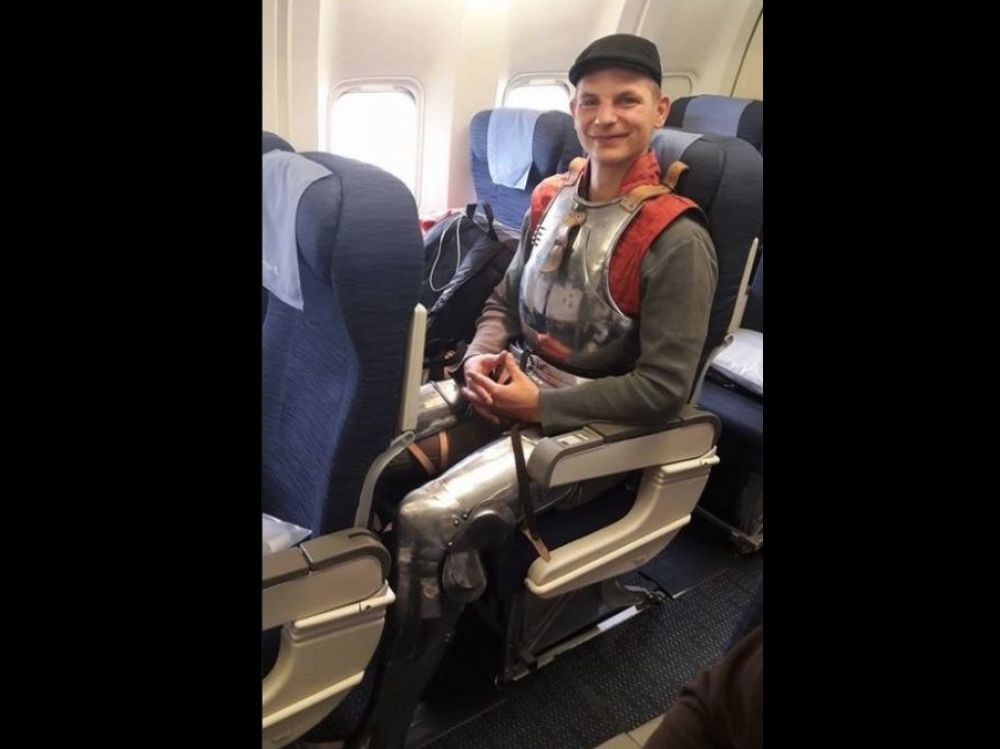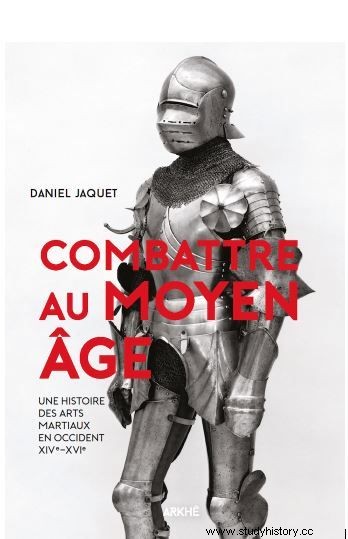Historian Daniel Jaquet conducts research on the art of combat in the Middle Ages... and tests armor on him!

Historian Daniel Jaquet in the flight taking him from Geneva to New York on September 20, 2017.
Neither Godefroy de Montmirail, nor knight of Puy du Fou, Daniel Jaquet exercises a very serious profession. For several years, this medievalist has been interested in the art of combat in the Middle Ages to which he has just devoted a book (Fighting in the Middle Ages, a history of martial arts in the West XIV-XVIth century published by Arkhé). But what especially characterizes this historian associated with the Center for Higher Studies of the Renaissance in Tours, is his taste for experimentation!

©Editions Arkhé
This enthusiast has in fact gone from the theoretical study of manuscripts and treatises on the martial arts of the XIV th century... to the practice of these fights... moreover in armour! To do this, Daniel Jaquet has designed armor that is sufficiently authentic to be usable within the framework of an experimental archeology approach. And, since then, he does not hesitate to use it in everyday life! So Daniel Jaquet has already tested his equipment at the supermarket, jog in a park, climbed a climbing wall, taken the Paris metro… and even flew between Paris and New York in September 2017!

Daniel Jaquet, the medievalist who tries everything! ©Daniel Jaquet
"I had to go to the Metropolitan Museum in New York where I was officially invited to give a lecture , he explains with a smile. For reasons of weight, bulk and cost, the solution of wearing the armor on me was considered to be the best one". With duly stamped permissions, Daniel Jaquet was able to board the plane, however before having to undress his armor each time he passed airport gates. "I admit, however, that I did not make the American customs officers laugh …", visibly less receptive despite all the passes.
It was thanks to the financial support of a foundation that Daniel Jaquet entered the very closed market of armor manufacturers several years ago and came into contact at the time with one of the best specialists in the Czech Republic to manufacture a copy. "We had to make compromises in the process of copying, of course, because what interested me above all was to be able to do a behavioral study, to see how we moved with this equipment on our back rather than to attach to exact number of rivets ", explains Daniel Jaquet. The model produced is thus based on armor kept in Vienna (Austria) and on the results of metallographic work carried out on this equipment from the 15th century. century by specialist Alan Williams of the Wallace Collection museum in London. "Thanks to this, we knew the composition and the hardness of the parts that we could confront with our replica ", continues the expert.

Daniel Jaquet during a demonstration in armour. ©Daniel Jaquet
The shaping of the armor and the thirty pieces that compose it was made from a sheet of industrial steel, in a body oven. "In the Middle Ages, we did not buy complete armor, but different pieces to make assemblies" , explains the expert. Similarly, the weight was variable depending on the activity. "For chivalrous games in tournaments, the helmet could weigh up to 6 kg, but to go to war, only 2kg helmets or salads were worn" , specifies the historian for whom the armor must be used above all to study the "normed" fights, the coded and ritual fights which appear in the manuscripts.

Illustration of medieval combat from the manuscript "Les Fais et les Dis des Romains", (1473-1480). © Editions Arkhé
These tests carried out in the laboratory with motion capture (motion capture 3D ) have already allowed him to understand what were the limitations imposed on the mechanics of the body to better understand the way in which movement was codified "and thus be able to better interpret the texts" . Another discovery:natural movements had no limitations. Walking with or without armor makes only a tiny difference in terms of mobility. "Ankle flexion extension is even greater in armor due to the weight being carried!" , says the historian. On the other hand, tests carried out on all the joints in the three directions of movement revealed limitations of around 20%. "In reality, for tactical and protection reasons, certain arm movements were deliberately restricted so as not to expose the weaknesses of the armor, which could have been exploited by the adversary" .
